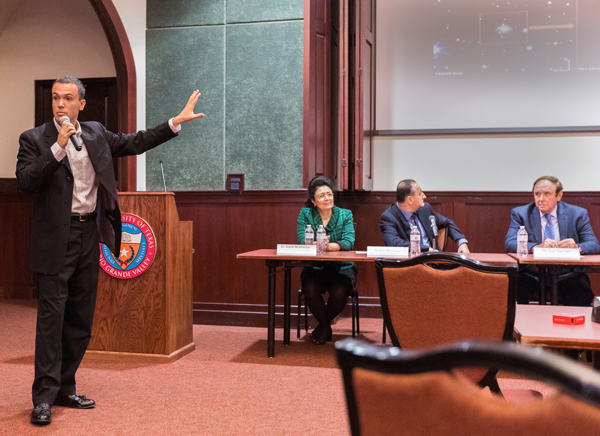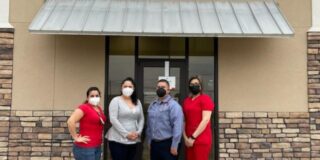- La Feria Native Soon To Retire From The Military This Summer
- Senior Eneece Avila Takes Pride in her State Title
- Dr. Noemi Infante, Harlingen Medical Center Open New Women’s Clinic
- Santa Rosa Cameron County Park Partially Reopens
- Santa Rosa Takes to Regionals Meet in Kingsville, Tx
- Long-Standing Nexstar Tower in La Feria Decommissioned
- Lionettes Powerlifting Meet
- Local Business Holds Event to Benefit RGV Shriners Club
- Knights of Columbus Holds it’s 30th Annual Golf Tournament
- KGBT Tower Dismantled
UTRGV’s Center for Gravitational Wave Astronomy Part of First Observation of Neutron Stars Collision
- Updated: October 27, 2017

UTRGV Center for Gravitational Wave Astronomy researcher Richard Camuccio, B.Sc., explains during a press conference Monday on the Brownsville Campus about the role of CGWA scientists in the detection of a new event in which, for the first time, the collision of two neutron stars were detected both by the gravitational waves it created and by the light it emitted. Photo: David Pike/UTRGV
by Vicky Brito
BROWNSVILLE, TEXAS – Scientists from the Center for Gravitational Wave Astronomy (CGWA) at The University of Texas Rio Grande Valley, along with thousands of scientists around the world, have announced the first-ever observation of the collision of two neutron stars.
A panel of CGWA faculty and student researchers participated in a press conference Monday morning on the UTRGV Brownsville Campus, directly after an international announcement livestreamed from Washington, D.C., by the National Science Foundation (NSF) and the LIGO-Virgo Collaboration.
The UTRGV panel was on hand to explain the science involved, as well as the university’s role in this major astronomical discovery.
The detection by LIGO came at 8:41 a.m. (ET) Aug. 17. After analysis of the signal, it was determined that a neutron star had collided with a second neutron star – about 130 million light years away. The LIGO and Virgo detectors were able to place the light source over the sky in Chile by means of a Swope telescope.
Dr. Adam Zadrozny a CGWA researcher in Brownsville, described the event as being like “looking for the needle in the haystack. We know these kind of events are not very common,” he said.
Richard Camuccio, B.SC, a UTRGV physics graduate student, said the discovery is a new way to measure the expansion of the universe using both gravitational waves and electromagnetic radiation.
A number of UTRGV researchers involved are part of TOROS – Transient Optical Robotic Observatory of the South – a research initiative that works with the United States, Argentina, Chile and Mexico to develop an astronomical observatory in the Southern hemisphere. TOROS has an instrument located at Brownsville’s Resaca de la Palma State Park.

Dr. Guillermo Valdés, a postdoctoral student at the LIGO Laboratory in Livingston, Louisiana, who conducted his PhD work at UTRGV, spoke during a press conference Monday on the Brownsville Campus about the role of the UTRGV Center for Gravitational Wave Astronomy in the first-ever observation of the merger of two neutron stars. The astronomical collision was detected by the gravitational waves it created, as well as by optical observation of the light it emitted. Photo: David Pike/UTRGV
Dr. Mario Diaz, director of the UTRGV CGWA, was out of the country and unable to attend the event, but sent a prepared statement.
“This is a significant milestone for the history of our CGWA,” he said.
At the time of the press conference, Diaz was in Buenos Aires conducting interviews there about the neutron detection and seeking support for the development of a new astronomical observatory in the northern mountains of the country, by many accounts one of the best places in the world to observe the sky.
Diaz thanked the NSF and NASA for their support on this project, and said students are the main reason behind CGWA’s success.
Dr. Juan Sanchez, UTRGV interim vice president for Research, Innovation and Economic Development, called the discovery a “truly outstanding sequence of events.”
“The detection of gravitational waves has by far been the most elicit goal of physics in history,” Sanchez said. “Since they were predicted with general relativity, it took approximately 101 years to actually detect them. The events of the last 12 months have been extraordinary, and it began with the first detection of gravitational waves last year.”
CGWA scientists were part of the team of some 1,000 scientists around the world who had a role in that first detection of gravitational waves (ripples in timespace), which was created by the merger of two black holes.

Karla Ramirez, UTRGV graduate student and CGWA researcher, spoke during a press conference on the Brownsville Campus about the role of UTRGV’s CGWA scientists in the detection of a new event in which, for the first time, the merger of two neutron stars was detected both by the gravitational waves it created and optically, by the light emitted. Photo: David Pike/UTRGV
Sanchez said the impact of these discoveries, along with UTRGV’s involvement in them, is multifaceted.
“In becoming a research university, this is a momentous development. It puts the CGWA at the forefront, on the leading edge of physics research. It places the UTRGV physics department among the most competitive research facilities in the world,” he said.
Dr. Soma Mukherjee, chair of the UTRGV physics department, said that for UTRGV and for the Rio Grande Valley, this was not just a simple discovery.
“This proves what is possible,” she said, “and I hope the work of our faculty members and students inspires young students who are aspiring to a scientific career to become aware of the kind of work we are doing, and of the global impact of the research at UTRGV.”






